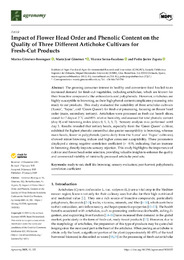Título :
Impact of Flower Head Order and Phenolic Content on the Quality of Three Different Artichoke Cultivars for Fresh-Cut Products |
Autor :
Giménez-Berenguer, Marina
Giménez, María José
Serna-Escolano, Vicente
Zapata, Pedro Javier |
Editor :
MDPI |
Departamento:
Departamentos de la UMH::Tecnología Agroalimentaria |
Fecha de publicación:
2025-01-27 |
URI :
https://hdl.handle.net/11000/38013 |
Resumen :
The growing consumer interest in healthy and convenient food has led to an
increased demand for fresh-cut vegetables, including artichokes, which are known for
their bioactive compounds like antioxidants and polyphenols. However, artichokes are
highly susceptible to browning, as their high phenol content complicates processing into
ready-to-eat products. This study evaluated the suitability of three artichoke cultivars
(‘Lorca’, ‘Tupac’, and ‘Green Queen’) for fresh-cut processing, focusing on flower head
order (main, secondary, tertiary). Artichokes were processed as fresh-cut hearth slices,
stored for 7 days at 2 ◦C and 85% relative humidity, and assessed for total phenolic content
(day 0) and browning index (days 0, 1, 3, 5, 7). Sensory analysis was performed until
day 3. Results revealed that tertiary heads, especially from the ‘Green Queen’ cultivar,
exhibited the highest phenolic content but also greater susceptibility to browning, whereas
main heads, lower in polyphenols (particularly from the ‘Lorca’ and ‘Tupac’ cultivars),
showed minor browning indices and higher consumer acceptability. These parameters
displayed a strong negative correlation coefficient (>−0.9), indicating that an increase
in browning directly impacts sensory rejection. This study highlights the importance of
cultivar and flower head order selection, providing valuable insights to
|
Palabras clave/Materias:
ready-to-eat
shelf life
browning
sensory evaluation
post-harvest
polyphenols
correlation coefficient |
Área de conocimiento :
CDU: Ciencias aplicadas |
Tipo de documento :
info:eu-repo/semantics/article |
Derechos de acceso:
info:eu-repo/semantics/openAccess |
DOI :
https://doi.org/10.3390/agronomy15020322 |
Publicado en:
Agronomy 2025, 15(2), 322 |
Aparece en las colecciones:
Artículos Tecnología Agroalimentaria
|
 La licencia se describe como: Atribución-NonComercial-NoDerivada 4.0 Internacional.
La licencia se describe como: Atribución-NonComercial-NoDerivada 4.0 Internacional.
.png)
